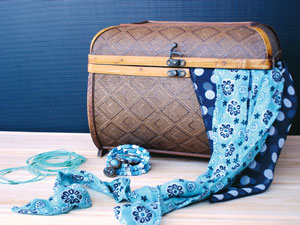A trunk show can be a great way to introduce new products to your customers without having to place a large investment. Plus, such shows often bring in new customers and tend to give your business a sense of mystery and élan that other shops might not have. Trunk shows are great for jewelry or fashion accessories, especially with the abundance of smaller artist-designed lines available, but they can work just as well with other products. To create a successful sale, it’s key to bring in a unique but complementary line, make it a special event and promote, promote, promote. Here are some tips for having a fabulous and profitable trunk show.
1. Choose the Perfect Vendor to Work With
A trunk show allows you to try out different merchandise or offer one-of-a-kind or custom pieces. By bringing in a sampling of merchandise, you can see how well your customers connect with the product and then be able to make an informed decision about whether you want to carry the line full time. You may be considering offering a younger, trendier fashion collection or a more edgy jewelry line than you traditionally carry. The trunk show can be your testing grounds. Or perhaps you want to hold a trunk show just to offer different lines once in a while, not necessarily to bring them into your store full time.
Whatever the purpose of the show, you need to find the best vendors to partner with. To find potential vendors, visit the handmade sections of trade shows where you’re likely to find a variety of smaller, more unique vendors. Talk to vendors with interesting products that complement your store. You can also start a list of companies or lines that customers ask about. Contact the companies that interest you to see if they have ever participated in trunk shows before, or if they are open to the idea. Ideally, you want to find someone that understands the business end of such an event and also meshes well with your personality and store style. You may not want a hippie surfer dude selling hemp necklaces if your store and clientele tends to be more conservative. Likewise, you don’t want a vendor that is very pushy if your selling style is more laid back.
Although handmade lines tend to work well for trunk shows, you could also hold such an event with a larger vendor that’s introducing a new line. A company representative might be willing to come out with samples and show the merchandise to your customers. Plan on contacting potential vendors at least four to six months in advance.
2. Plan the Best Time for the Event
Like any successful event, a trunk show takes planning. Look at your calendar at the beginning of the year and determine what month would be ideal. Pick a time of the year that works well with the merchandise, but stay away from the typical “sale seasons.” You don’t want to hold a trunk show in January when most customers are in the “post-holiday sales” mindset or after they’ve spent all their money on the holidays. The best time to hold trunk shows are at the start of a selling season. After all, you want to be showing new and unique merchandise that is special and worth the full price, not sales items. Another alternative could be during a slow season, such as April or August.
Determine whether the show will be an exclusive after-hours event that’s held only one day, or whether it will be something that runs over three or four days. If you have enough potential customers for a private event, this may be the way to go. However, if you’re looking to the trunk show to help determine if a new line is good for your store, a three- or four-day event will reach more customers and give you a better idea of how the line goes over to your entire customer base.
One thing to keep in mind, don’t hold more than three trunk shows in one year; customers will get burned out and the events will no longer be special.
3. Get Everything in Writing
Although you are not paying upfront for merchandise, you still have costs involved. Like any business venture, it’s important to get everything in writing. Discuss with the vendor or artist what his or her responsibilities will be. Will you want the artist on site to demonstrate and sell the products? Will she need to do the set-up or will you, or will you work together on that? How much merchandise will the vendor supply, and will it be all finished pieces or can some of it be samples only? What about custom items? Who will handle the actual transactions, you or the artist? What will be the profit split? Typically, it is 50/50, but that’s something you will have to work out with the artist. What if there are returns? Who handles that? Also discuss how each party will contribute to promoting and marketing the event.
4. Promote, Promote, Promote
A trunk show will never be successful without strong promotion. Several weeks before start talking up the event. Print out flyers or postcards and have your sales staff mention the show to every customer while simultaneously handing them a flyer or postcard. Create large full-color posters to hang in your window or around your store. Talk with the artist about any marketing materials or images he or she might have. Vendors oftentimes have advertising co-op money that might help defray costs. Create an event on your Facebook page as well as the vendor’s Facebook page. Keep posting about the event in the weeks and days beforehand. Likewise, Twitter about the event, or post pictures of the products on your Pinterest page with information about the trunk show. By posting on both yours and the vendor’s social media sites, you are reaching double the audience.
Send a press release to your local paper playing up the exclusiveness of the line and event. Discuss how the pieces are made and encourage people to come meet the actual designer. Feature the event prominently on your website, along with some background on the artist and perhaps a short video about the products.
Send e-mail announcements to your customers and follow up with a second e-mail. Likewise, send several rounds of postcards or other direct mailings. People need more than one impression to remember something.
If the trunk show is going to be a private event, analyze your customer database for the key customers to invite. Aim for at least 50 people. Choose those customers that have purchased similar items in the past, have generally paid full price for items, or who typically attend your events. Don’t waste the effort on someone who only shops occasionally and then only when you have sales. Personalize the invitations with a handwritten note. After all, this is an exclusive event only for them; make it look that way.
5. Truly Make it an Exciting Event
Plan on setting up a special area in your store for the trunk show. Perhaps drape fabric or hang other elements around the area to set it off from the rest of the shop. You could even lay down a special carpet or rug to distinguish the uniqueness of the area. Plan with the vendor how to best show the product. You want to go for interesting display pieces and props, not the typical wire racks or standard risers. Set up a section in your window highlighting the trunk show and encouraging customers to come in to see more. Place a sandwich board outside your shop announcing the event and stating “Happening Now!” Or just use chalk to write on your sidewalk outside the shop, and keep your door open and inviting during the trunk show.
Offer some refreshments for those that come, especially if the show is a private event. Cheese, crackers and wine or flavored teas are great, but consider the nature of the merchandise and the feel you are trying to evoke. If the pieces are more fun and hip, then trendier finger foods might be appropriate.
Be sure to have signage around the display area reflecting that this is special merchandise and only available for a limited time. Likewise, hang color photos of the merchandise being made, or run a slideshow on a digital picture frame or iPad showing the pieces and the process in how they are created. Encourage the artist or vendor to interact with as many customers as possible. She is the star and people want to meet her. If the vendor is not available during the entire show, be sure that a fully informed staff member is dedicated to the area and can speak knowledgeably about the product.
6. Price Appropriately
A trunk show is an exclusive event, not just another sale. As such the pricing should reflect this. Don’t offer discounted merchandise. Instead, consider noting in the marketing materials and signage that items are “Specially priced for the event.” This gives the impression that customers are getting a deal but doesn’t specify a certain percentage off or sale amount. While many customers will purchase items at the full price for a chance to buy something truly unique, others might still be looking for a bargain. Consider offering a discount on other merchandise in your store for anyone attending the event, or give away a gift with purchase. You can also give everyone a bounce-back coupon. They might not have purchased something that day, but if you can offer them an enticement to come back, they might purchase on a subsequent trip. Just be sure to offer the coupon only after they’ve made any purchasing decisions, and be sure the offer is good only for a future visit.
7. Follow Up for Success
During the event have a sign-up sheet where you can capture customers’ names, e-mails and addresses. Even if they didn’t buy anything, they were interested enough in the event or merchandise to come, therefore, they are prime targets for further marketing efforts. One way to get people to sign such a list is to give away a prize. Perhaps offer a custom-made necklace and earring set to one or two winners, or give away a $100 coupon for anything from your store. If you can get information on 300 potential new customers, it’s worth the $100 investment.
After the event be sure to follow up with the artist or vendor. Thank them for participating and if you both were pleased with the results consider when you might be able to hold another show. If any custom orders were placed, discuss with the vendor how they will be handled and when the customer can expect the merchandise.
Be sure to take photos or videos during the event and post them on your website and Facebook page. Announce your winners on your website and social media sites as well. Posts like this will encourage customers to want to see what all the fun was about the next time.
If after the trunk show, you decide to carry the line in your store on a full-time basis, be sure to send an announcement to all your customers, and send a special e-mail or postcard to anyone who bought items during the trunk show. Oftentimes people would like to buy more than they actually do. Telling them you know carry the line full-time might encourage them to come back and make the additional purchase they didn’t during the event.
A trunk show can create a sensation for all those involved. Customers get treated to special and unique merchandise, plus get to enjoy a fun night out. The artist or vendor gets added exposure and sales for his or her products. Plus, it allows him or her to see how shoppers actually react to the merchandise. The store gets the added sales, the exposure of a new line and potential new customers. Done well, everyone wins.
For more tips on trunk shows, check out these other articles on the web:
10 Ways to Plan a Successful Trunk Show and Boost Your Sales









